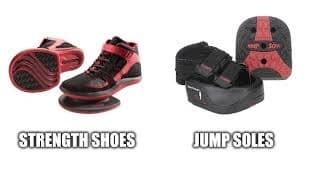
Ever since tools like Jumpsoles and Strength Shoes were first introduced to the market, there has been conflicting feedback on whether they increase your vertical jump.
Honestly, controlled experiments only ever tell some of the story and do not necessarily paint a complete picture. You also cannot ignore that there are those in the industry who have an agenda to advance - and that is something they are not always going to tell you openly.
Before you consider the purchase of jumpsoles or strength shoes, there are a few sober considerations that you need to make.
The first consideration is money. Will that additional expenditure be worth it in the end?
The second consideration is whether the jumpsoles will actually help you achieve better jumping results faster than you would ordinarily do, while using regular shoes for jumping.
The third consideration you need to make is the risk to injury.
Finally, the jury will also remain out on just how much of an impact these shoes will make when you no longer have them on. Will your body be able to make the transition needed for a more competitive environment?
What Are Jumpsoles?
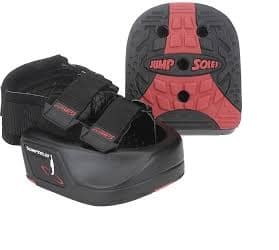
While this product has evolved a considerable amount since it was first patented, the underlying principles remain the same across the board.
The person who purchases jumpsoles wishes To Increase Vertical His Jump. A regular jumpsole is a device created to assist amateur and professional athletes with lower body Plyometrics exercises. If you have read any of our other pages, you will already know that plyometrics - on their own - are highly effective for those wishing to Jump Higher.
Jumpsoles were created to help you achieve - and even surpass - those jumping aspirations a lot earlier or quicker than regular jump training. That is the basic mantra with jumpsoles - better results and in a shorter time.
The use of a jumpsole is really an attempt at a training shortcut. If we strip a jumpsole down to its nuts and bolts, you will have a product that essentially features an elevated sole and a cover which is attached to the sole. Both of which are designed to accommodate the front half of your foot, while you are wearing another pair of shoes underneath that.
Because your foot needs to fit into this covered sole, the rear end of the product remains open - although with the advances made in technology there are now variations to this. The covers aren’t even complete anymore, as most jumpsoles just have straps above the expanded sole, locking or securing the foot into the jumpsole.
The jumpsole is also designed in such a way that your heels are actually kept off the ground during jump training. Some parts of your modern jumpsoles have an elastic component to them, while others do not. That is all supposed to contribute to the scheme of Jumping Higher.
How Do Jumpsoles Increase Your Vertical?
A primary reason for jumpsoles is to put more pressure on the front half of your foot, the part of the foot that you should be jumping off anyway.
When you use jumpsoles, you are also supposed to witness some kind of increase in capacity for the ankles when jumping.
One of the reasons for jumpsoles keeping your heels above the ground is to better target the calf muscles - with the view to increasing the explosive power output in your lower body when jumping.
At the bottom of most jumpsoles, you will also find an array of little studs. Among other things those studs help an athlete to increase his traction with the surface when jumping.
Among the exercises where this shoe is supposed to be most effective is while performing squatting exercises or any jump training exercise which incorporates the countermovement.
When considering the purchase of a jumpsole, try to think of what it is like to either walk, run or even jump while on the sand. The designers of this shoe have gone for the same sort of effect here. The intentions are to try and replicate those deep movements that your feet and calves need to make while digging into and lifting out of the beach sand.
What Impact Do Jumpsoles Have On Your Vertical Jump?
The best way to try and establish if jumpsoles “deliver on deadline and under budget” is by evaluating their performance over a short period of time.
The two facets you are looking to evaluate are the vertical jump height (with a countermovement) and the agility levels achieved when jumping.
Following an eight-week training programme that included the lateral cone hop, bounding, skipping, box jumps, squat lunges, rim jumps and step ups, there is some evidence to suggest that the results achieved with jumpsoles are more compelling than those achieved with a regular plyometrics programme.
Perhaps there is a method to the madness afterall!
After four weeks of training, the change with jumpsoles on is more than 4cm greater than the change recorded without the jumpsoles. After eight weeks of the same training, the jumpsoles outperform regular trainers by more than 7cm.
There is also some evidence to support the claims that jumpsoles improve agility in an athlete at a far greater rate than regular trainers.
Nevertheless, it is worth noting that because there is very little about this training method that comes naturally, your exposure to injury will increase. That is just a little mental note that you ought to make before embarking on a jumpsoles campaign, as it were.What Are Strength Shoes?
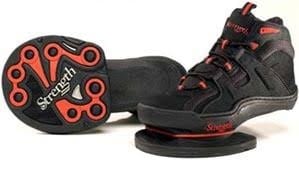
Much like jumpsoles, the strength shoe has evolved a considerable amount since it was first patented as a product. The strength shoes that you find in stores today are far more flashy and glamorous than what the original designers of exercise shoes had envisaged several years ago now.
The most defining feature on a strength shoe is the flexible pillar sole, which is remarkably visible on the front end of the shoe. The primary objective of a strength shoe is precisely the same as that of a jumpsole, in that it seeks to keep a training athlete’s heels off the ground.
That is why the front half of the sole is elevated in the way that it is. It does have one less complication though - and that centres around the manner in which the foot is fitted into the shoe.
With jumpsoles you actually have to put another set of regular shoes on, before strapping your feet for training. With the strength shoe, it is quite literally just a matter of putting that shoe on, as if it were merely regular shoe.
Beyond that, the thought process that went into the design of the strength shoe is remarkably similar to that which went into the design of the jumpsole. The desired objectives are exactly the same, really!
How Do Strength Shoes Increase Your Vertical?
Those who design and sell strength shoes will tell you that they develop muscle strength, coordination and even endurance in a manner which is quicker and more efficient than what you would ordinarily get out of a regular jump training workout.
Similar to jumpsoles, strength shoes will promise you better speed, agility and more explosive power when jumping.
When jumping, the extensor muscles are responsible for the extending and flexing of the limbs, whether that be on the lower or upper body.
The designers of the strength shoe claim that the product will better develop the extensor muscles in the legs, lower legs, feet, calves, quads, thighs and glutes.
The designers of the strength shoe will also tell you that the product will increase muscle mass and strengthen the muscles in your lower limbs. If we accept that is true, that will also contribute to an increase in your vertical.
With the jumpsoles, a deep concern that has been raised by many centred around the exposure to injury, because of how vulnerable that left the ankles and other joints in the lower body.
The strength shoe actually promises more stability in that area. Stronger ankles and joints should contribute to an increased vertical, in theory anyway. However, some might argue that the jury is still out on that too. There have been reports of injury, following the use of strength shoes elsewhere and they should not be ignored.
The strength shoe is also believed to better develop the inverters, evertors and rotators of the leg - all of which are critical to the movement that the human body makes when jumping.
What Impact Do Strength Shoes Have On Your Vertical Jump?
For every study claiming jumping success, following the use of strength shoes, there is probably one which makes findings to the contrary. Because jumpsoles have already been given a positive verdict in the paragraphs above, we thought it might be fitting to glean a little from what the skeptics have to say this time.
There is evidence that does suggest strength shoes increase the physical demands on your body, without producing compelling jump outcomes. Because of that, the jury is out on whether strength shoes are actually worth all of the trouble. Afterall...walking, running and jumping with the use of just the front half of your foot is not anybody’s idea of a countryside picnic.
Once again, we can’t deny that the jumping improvements recorded with the strength shoes were greater than those recorded by those who conducted training with regular shoes.
However, the jury is still out on whether the difference between the two is great enough to justify an increased risk to injury and ultimately added expenditure.
The people who sell you these products, also sell you incredible vertical jump dreams. That is something you ought to be wary of, before making any purchase.
Three Types Of Strength Shoes
1-) Jumpsoles
The V 5.0 Speed and Jump Training System can still be purchased at online vendors but it will not cost you less than $150, which can be an eye-watering amount for somebody who is probably never going to scale the same heights as Michael Jordan. To be fair, that is not what the vendors are promising you.
What the system, which includes a training manual and a training DVD, does promise though is the development of fast twitch muscle fibres, which are indeed a critical component for those wishing to jump higher.
It is worth noting that if you have a young teen, who still has some growing to do, the purchase could be worth it - that is assuming that the desired outcomes are achieved during jump training.
Unlike Strength shoes, you can still use jumpsoles as your feet grow. That seems to be a plus for us!
A lot of parents' feedback about these shoes seems to suggest that there has been a noticeable improvement in the vertical jump and explosive performance from their children.
People who have generally complained about the product are the adults, so one does have to wonder if the purchase of the shoes merely coincides with a child’s natural development.
Without more information, it is difficult to say but there are some doubts. We will leave it at that.
2-) Strength Shoes
The Jump 99 Strength Plyometric Training Shoes will set you back $125. That is cheaper than the JumpSoles system we mentioned above...that is a good place to start. If it is cheaper, then what are you actually getting for that lower price?
For one, you are getting a claim that your vertical jump will increase by 5-10 inches. At face value, there is nothing wrong with that.
You are also getting a promise that you will run faster and produce greater explosive power, although they do not say how much greater this will be than what you would ordinarily achieve with regular jump training shoes.
We already know about the better developed fast twitch muscle fibres, from the jumpsoles, along with the increased muscle mass in the calves. Interesting to note is that this Strength Shoes package does not include a training video, training manual or workout plan. Maybe that is where the extra $25 went?
Suffice it to say, customers are generally a lot happier with these, than they are with jumpsoles, primarily because they are generally a better fit and less awkward. Oh, and they are a lot easier on the eyes than the jumpsoles! Somebody really needs to call the fashion police on that one.
3-) APL Shoes
Well, APL shoes remain somewhat of a mystery to many. They were banned by the NBA, which confirmed claims made by the company that they will make you jump higher. That is kind of a good thing.
The Men’s Concept Boomer will set you back at least $200. The most compelling feature about APL shoes is that they are well...just shoes, except that they aren’t of course. They are also effectively performance enhancers, much healthier than drugs and EPO. Lance Armstrong might have a different view on that though.

The designers of this shoe attribute the increased vertical leap, that comes with the territory when purchasing these, to the company’s “APL Load 'N Launch” technology. It is that technology which remains a point of contention for basketball administrators in the United States.
While the NBA is clearly convinced by the higher jump performance claims - and that should really be enough to seal the deal - the jury is probably still out on just how much higher these shoes will make you jump. There does not appear to be an overwhelming amount of research around that.
The APL shoes are high top shoes, without the strange soles that come with jumpsoles or the regular strength shoes that we have spoken about above.
The shoes are also different in that they are not just training tools - well they aren’t really training tools at all. They are performance shoes.
They also look good. If you just like good looking shoes, then these are your guys.Best Way To Increase Your Vertical Jump
You are most likely to jump higher than your peers if you train harder than them, for longer than them and ultimately better than them. Any ambition of ever jumping higher will only really be achieved if you are disciplined and knowledgeable on the options that you have at your disposal.
There are two programs that have become increasingly popular during the past decade and a bit and they will promise you a tremendous amount too.
The feedback on these programs does tend to be mixed but in the interests of offering benefit of the doubt, we will tell you about the best of those claims.
1-) Vert Shock
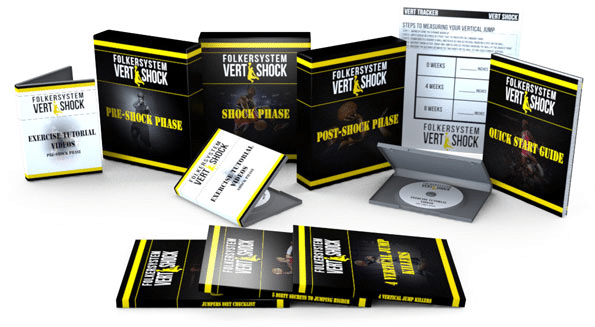
To be fair enough, let's not use me as an example ONLY and check out other peoples progress with the program. Basketball fanatic Andy used the Vert Shock program and reported an increase to his Vertical Jump of 8 inches, after following the program for just eight weeks. The designers of the jump training program claim your vertical jump will be increased by anything between 9-15 inches after the eight weeks. So, 8 inches seems close enough. That is pretty fair.
During the Vert Shock program, you will be required to stay disciplined during the completion of 41 workouts. That equates to a touch over five workouts for the week - it is a serious business if you are willing to try the program.
There are a lot of advanced plyometrics included in the programme, there are also core strength exercises included in the programme and there are also exercises which are primarily dedicated to increasing the power output in your lower body. So, it is really the full spectrum of workouts - a comprehensive programme if ever there was one.
Check My Before and After Review Here.
2-) The Jump Manual
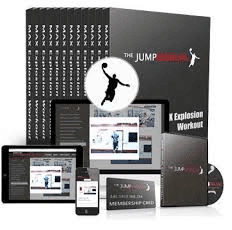
Another basketball fanatic, Ben, gained 13 inches after completing the Jump Manual program. The designers of the program claim you can actually increase your vertical by up to 20 inches, with the right discipline and application.
There is a considerable amount of emphasis on science, nutrition and technique with this program.
Unlike Vert Shock, you need 12 weeks for the completion of this dedicated programme, which would invariably include five workouts per week.
Plyometrics and strength exercises are incorporated in this programme, much like that which you could expect from a Vert Shock programme. However, it would be remiss of us to not point out that Vert Shock places immense emphasis on the advanced plyometrics aspect.
Check My Full Review Here.
Conclusion
There will invariably be some skepticism about jump training programmes that you have to pay for, that promise a considerable amount without there really being any guarantee that they will deliver.
However, if I were a gambling man (which I am), I would still take my chances on those jump training programmes (Vert Shock and Jump Manual), ahead of the fancy shoes that promise even more than said programmes and then proceed to tell you that those objectives can be achieved by doing less work instead of more work.
For us, that is the red flag here.
Say what you like about Vert Shock and the Jump Manual but at least they demand a considerable amount from you in return. There is the expectation that you will put in the time and the work required to produce results. It is never just as simple as putting on added soles or shoes with added soles attached to them...and then walking and training in those shoes.
The answer is clear, really. Jumpsoles and Strength Shoes are not worth the trouble. Just teach yourself to roll up your sleeves, hunker down and work harder while you are at it.
Be good, or be good at it!
Hey, I’m Aleksandar and I am a Basketball freak! That is why I decided to create this blog. Teaching people How to dunk a basketball and How to Jump Higher in this sport or other related sports that require vertical jumping, is my specialty. If that’s your aim, then you have come to the right place.
